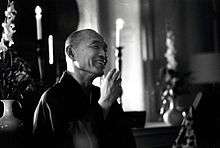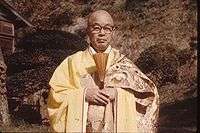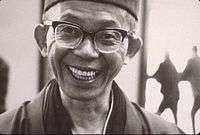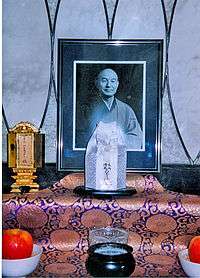Taizan Maezumi
Hakuyū Taizan Maezumi (前角 博雄 Maezumi Hakuyū, February 24, 1931–May 15, 1995) was a Japanese Zen Buddhist teacher and rōshi, and lineage holder in the Sōtō, Rinzai, and Sanbo Kyodan traditions of Zen. He combined the Rinzai use of kōans and the Sōtō emphasis on shikantaza in his teachings, influenced by his years studying under Hakuun Yasutani in Sanbo Kyodan. He founded or co-founded several institutions and practice centers, including the Zen Center of Los Angeles, White Plum Asanga, Yokoji Zen Mountain Center and the Zen Mountain Monastery.
Hakuyū Taizan Maezumi 前角 博雄 | |
|---|---|
 | |
| Title | Rōshi |
| Personal | |
| Born | February 24, 1931 Otawara, Tochigi Prefecture, Japan |
| Died | May 15, 1995 (aged 64) |
| Religion | Buddhism |
| Spouse | Martha Ekyo Maezumi |
| Children | Kyrie Maezumi Yuri Jundo Shira Yoshimi |
| School | Sōtō Rinzai |
| Lineage | Baian Hakujun Dai-osho[1] |
| Education | Komazawa University |
| Senior posting | |
| Predecessor | Baian Hakujun Kuroda Koryū Osaka Hakuun Yasutani |
Taizan Maezumi left behind twelve dharma successors, appointed sixty-eight priests and gave Buddhist precepts to more than five hundred practitioners. Along with Zen teachers like Shunryū Suzuki, Seungsahn, Joshu Sasaki and Hsuan Hua, Maezumi greatly influenced the American Zen landscape. Several Dharma Successors of his—including Tetsugen Bernard Glassman, Dennis Merzel, John Daido Loori, Jan Chozen Bays, Gerry Shishin Wick, Joko Beck, and William Nyogen Yeo—have gone on to found Zen communities of their own.
Maezumi died unexpectedly while visiting Japan in 1995.
Biography

Maezumi was born in Japan on February 24, 1931 to Yoshiko Kuroda-Maezumi and Baian Hakujun Kuroda, a prominent Sōtō priest, in his father's temple in Ōtawara, Tochigi. In later years, he took the name Maezumi, his mother's maiden name. He was ordained as a novice monk in the Sōtō lineage at age eleven, and in high school began studying Zen under a lay Rinzai instructor, Koryū Osaka. While studying under Koryu he attended Komazawa University—receiving degrees in oriental literature and philosophy. After college he trained at Sōji-ji, and then received shihō from his father in 1955. In 1956 he was sent to the United States to serve as a priest at the Zenshuji in Little Tokyo, Los Angeles, a Japanese-American neighborhood. He worked part-time at a factory.
The Zenshuji Soto Mission consisted of a Japanese-American congregation that placed little emphasis on zazen. Maezumi began sitting zazen occasionally with Nyogen Senzaki, in nearby Boyle Heights, Los Angeles for the next two years. In 1959 Maezumi took classes in English at San Francisco State University.The same year he met Shunryū Suzuki for the first time and occasionally visited Suzuki's temple, Sokoji, for ceremonies. Early in the 1960s, Maezumi began holding zazen at Zenshuji for Western students, which eventually led to the opening of the Zen Center of Los Angeles in 1967. That same year he married his first wife, Charlene (they divorced in 1971.)[2][3][4]
Also in 1967, Maezumi began studying with Hakuun Yasutani, completing kōan study under him and receiving inka (dharma transmission)[1] in 1970. He also received inka from Koryū Osaka in 1973,[1] making him a lineage-holder in the Sōtō, Rinzai and Sanbo Kyodan schools.[2][3][5][6]

In 1975 Maezumi married his second wife, Martha Ekyo Maezumi, and later the couple had three children (his daughter Kyrie Maezumi is an actress).[7] In 1976, Maezumi founded the non-profit Kuroda Institute for the Study of Buddhism and Human Values, promoting academic scholarship on Buddhist topics. The White Plum Asanga was also established during this period.[8] His senior student Tetsugen Bernard Glassman opened the Zen Community of New York in 1979 with Maezumi's blessing and encouragement. Another student, John Daido Loori, acquired land in the Catskill Mountains of New York and in 1980 established Zen Mountain Monastery (ZMM) with Maezumi; Loori was installed as Abbot at ZMM in 1989. That following year Maezumi founded a summer retreat for the ZCLA called the Yokoji Zen Mountain Center, which today serves as a year-round residential and non-residential Zen training center. In 1984 another student, Dennis Merzel, left ZCLA to establish the Kanzeon Sangha, an international network practicing in the Sanbo Kyodan lineage.[9][10][11]
Maezumi died on May 15, 1995 while visiting his family in Japan. He had been out drinking; returning home, he took a bath, where he fell asleep and drowned. Not long before dying, he had given inka (dharma transmission) to Tetsugen Bernard Glassman. He did this to emphasize the Sanbo Kyodan connection of his past into the Dharma transmission of White Plum Asanga, naming Glassman President of the organization in his will.[12]
Teaching style

Due to his training in three Japanese lineages, Maezumi employed both Rinzai kōan study and Sōtō shikantaza in his teaching curriculum—an approach developed by his teacher Hakuun Yasutani. He was known to be especially strict about the posture of his students while sitting zazen. Maezumi used a range of kōans from different Zen traditions, including the Blue Cliff Record, The Gateless Gate, Transmission of the Lamp, and the Book of Equanimity.[13][14][15] According to author and Dharma Successor Gerry Shishin Wick, Maezumi was also fond of a particular saying—"appreciate your life." This also is the title of a compiled book of teachings by Maezumi, published by Shambhala Publications. In it Maezumi says, "I encourage you. Please enjoy this wonderful life together. Appreciate the world just this! There is nothing extra. Genuinely appreciate your life as the most precious treasure and take good care of it."[16]
Criticism
Maezumi publicly admitted he was an alcoholic in 1983, and sought treatment at the Betty Ford Center. This coincided with revelations that he had been having sexual relationships with some of his female followers at the Zen Center of Los Angeles despite being married to his wife, Martha Ekyo Maezumi, "including one of the recipients of his dharma transmission".[17] According to Kirsten Mitsuyo Maezumi, this "caused the separation of my parents and was the reason my mother left the Zen Center of Los Angeles with my brother and [me] in 1983".[18]
Maezumi was forthcoming in admitting his mistakes and did not justify his behaviors.[5] These events caused much turmoil in his school, and many students left as a result. Some members who stayed described themselves as forced to see Maezumi on a more human level, even seeing this period as a breakthrough for them, no longer deluded into thinking a teacher could be beyond imperfection.[19] Both Bays and Tetsugen Bernard Glassman founded their own sanghas at this time.[7][20] When remembering Maezumi, author David Chadwick had this to say: "I'd say he had an interesting mix of humility and arrogance. Mainly to me he'd seem arrogant at a distance, but close up he'd be right there with me not putting on any airs."[5]
Influence

Maezumi named twelve Dharma Successors, ordained sixty-eight priests, and administered the Buddhist precepts to over five hundred individuals. Author James Ishmael Ford says,
His influence on the shape of Western Zen is incalculable." [21]
Jan Chozen Bays says,
To me, Maezumi's genius lay in his ability to see the buddhanature and also teaching potential in many different kinds of people. There are some Zen teachers who have no successors or maybe one or two. Maezumi was more the Tibetan style—scatter the seeds widely, some will grow and some will not. We won't know for several generations which of his successors have established lineages that will continue."[7]
His daughter Kirsten Mitsuyo Maezumi writes:
He was not a good father, or a good husband to my mother, but he was an outstanding teacher with a love for the dharma and a vision of liberation that took precedence in all he did.
As an adult, in my travels and own seeking, I hear testimonials to his awakened Buddha nature and hear and see the proof of it in the difference it has made for so many other gifted beings to step into their place as teachers and facilitators of peace and consciousness.
It is a lineage spanning continents and decades and I am very proud of him. It is the best consolation I can have; seeing and hearing his students teach.[18]
Dharma heirs
Maezumi Roshi gave Dharma transmission to the following individuals:
- Tetsugen Bernard Glassman
- Dennis Merzel
- Joko Beck
- Jan Chozen Bays
- John Daido Loori
- Gerry Shishin Wick
- John Tesshin Sanderson
- Alfred Jitsudo Ancheta
- Charles Tenshin Fletcher
- Susan Myoyu Andersen
- Nicolee Jikyo McMahon
- William Nyogen Yeo
Bibliography
- 1976 On Zen Practice: Body, Breath, Mind by Maezumi and Tetsugen Bernard Glassman
- 1978 On Zen Practice II: Body, Breath, Mind (a.k.a. The Hazy Moon of Enlightenment) by Maezumi and Tetsugen Bernard Glassman
- 1978 Way of Everyday Life
- 1998 Echoless Valley
- 2001 Appreciate Your Life: Zen Teachings of Taizan Maezumi Roshi
- 2001 Teaching of the Great Mountain: Zen Talks by Taizan Maezumi edited by Anton Tenkei Coppens
See also
References
- White Plum Asanga website
- Preston, David L. (1988). The Social Organization of Zen Practice: Constructing Transcultural Reality. Cambridge University Press. pp. 31–33. ISBN 0-521-35000-X.
- Ford, James Ishmael (2006). Zen Master Who?: A Guide to the People and Stories of Zen. Wisdom publications. pp. 162–166. ISBN 0-86171-509-8.
- Profiles of Zen/Ch'an Buddhists
- Chadwick, David (2004-06-14). "Memories of Taizan Maezumi". Cuke.com. Retrieved 2008-01-18.
- Maguire, Jack (2001). Essential Buddhism: A Complete Guide to Beliefs and Practices. Simon and Schuster. p. 184. ISBN 0-671-04188-6.
- Jones, Noa. "White Plums and Lizard Tails: The Story of Maezumi Roshi and his American Lineage". Lion's Roar. Retrieved 2008-01-25.
- Seager, Richard Hughes (1999). Buddhism In America. Columbia University Press. pp. 101–102. ISBN 0-231-10868-0.
- Oldmeadow, Harry (2004). Journeys East: 20th Century Western Encounters with Eastern Religious Traditions. World Wisdom, Inc. p. 298. ISBN 0-941532-57-7.
- Nay, David N. (2004). Tibetan and Zen Buddhism in Britain: Transplantation, Development and Adaptation. Routledge. p. 31. ISBN 0-415-29765-6.
- Ford, James Ishmael (2006). Zen Master Who?: A Guide to the People and Stories of Zen. Wisdom publications. pp. 169. ISBN 0-86171-509-8.
- Ford, James Ishmael (2006). Zen Master Who?: A Guide to the People and Stories of Zen. Wisdom publications. pp. 166. ISBN 0-86171-509-8.
- Kennedy, Robert E. (2000). Zen Gifts to Christians. Continuum International Publishing Group. p. 11. ISBN 0-8264-1654-3.
- Prebish, Charles S. (1999). Luminous Passage: The Practice and Study of Buddhism in America. University of California Press. pp. 16. ISBN 0-520-21697-0.
- Wick, Gerry Shishin (2005). The Book of Equanimity: Illuminating Classic Zen Koans. Wisdom Publications. pp. 1–2. ISBN 0-86171-387-7.
- Maezumi, Taizan (2002). Appreciate Your Life: The Essence of Zen Practice. Shambhala. ISBN 1-57062-916-1.
- Wright, Dale S. (2010), Humanizing the Image of a Zen master: Taizan Maezumi Roshi. In: Zen Masters, edited bySteven Heine and Dale S. Wright, Oxford: Oxford University Press, p. 245
- Maezumi, Kirsten Mitsuyo. "A Letter from Kirsten Mitsuyo Maezumi". Sweeping Zen. Archived from the original on February 24, 2015.
- Coleman, James William (2001). The New Buddhism: The Western Transformation of an Ancient Tradition. Oxford University Press. p. 178. ISBN 0-19-515241-7.
- Cushman, Anne (2006-03-29). "Under The Lens: An American Zen Community In Crisis". Tricycle: The Buddhist Review. Archived from the original on 2008-01-18. Retrieved 2008-01-25.
- Ford, James Ishmael (2006). Zen Master Who?: A Guide to the People and Stories of Zen. Wisdom publications. pp. 164. ISBN 0-86171-509-8.
Sources
- "Hakuyu Taizan Maezumi Roshi (Big Mind bio)". Big Mind. Archived from the original on 2008-01-09. Retrieved 2008-01-18.
- Fletcher, Charles Tenshin; David Scott (2001). Way of ZEN. Thomas Dunne Books St. Martin's Press. ISBN 0-312-20620-8.
- Sutton, Robert P. (2005). Modern American Communes: A Dictionary. Greenwood Press. ISBN 0-313-32181-7.
External links
- White Plum Asanga
- Obituary
- Je leven waarderen (Appreciating Your Life) TV documentary about Maezumi's life and work by the Dutch Buddhist Broadcasting Foundation. Netherlands/USA (2008) English w. Dutch subtitles, 60 min.